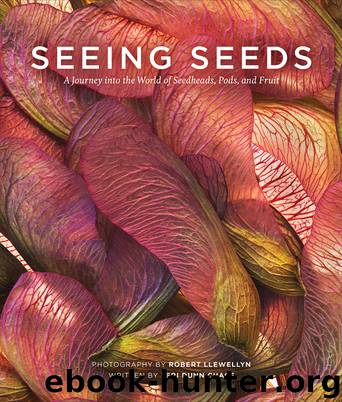Seeing Seeds by Teri Dunn Chace

Author:Teri Dunn Chace
Language: eng
Format: epub
Publisher: Timber Press
Published: 2015-03-09T16:00:00+00:00
Unlike other mulleins, moth mullein (Verbascum blattaria) forms beadlike seed capsules along its stiff stems. But, as is characteristic of the plant, these are two-celled and jampacked with tiny seeds. Not all of them open and spill their contents at season’s end. This might be deliberate, as the seeds require light to germinate and the odds will not be good when other vegetation hems in a plant.
Queen Anne’s lace
Daucus carota
When this common weed finishes blooming and, presumably, its many mini flowers have been pollinated, it enters a phase known as bird’s nest. The formerly lacy flowerhead curls inward and shelters the developing fruit. These fruit are small, oval-shaped, and covered with little spines or barbs. These are intended to adhere to the fur of animals, thereby aiding distribution. The spines are arranged in four neat ridges or rows, covering all sides efficiently.
Each fruit becomes gray-brown to yellow when ripe. It then splits into two halves, and two seeds inside are at last ready to travel. The plant continues to clutch them if the weather is humid, rainy, or snowy. Only on dry days does the bird’s nest relax and release the seeds to gravity, the wind, or passing creatures.
One plant can produce up to 4000 seeds. Like related plants, Queen Anne’s lace is biennial, meaning it develops a rosette and gets started on its whitish, carrotlike taproot during its first growing season, and it doesn’t send up a flower stalk until the following year or beyond. Those who have cut back this plant with a weed whacker or plowed under a patch know that if you don’t dig up the rosette, another flowering stalk may arise. This resilience is fairly unique among biennials. Add the prolific seed production and you can see why this resourceful plant is often considered an aggressive weed.
And yet the slim root is as edible and valuable for vitamin A content as the domesticated carrot (which, in fact, was derived from it). And the seeds, which have a pleasant carroty flavor, are as safe to eat as other umbelliferous herbs, like dill, caraway, and fennel.
Download
This site does not store any files on its server. We only index and link to content provided by other sites. Please contact the content providers to delete copyright contents if any and email us, we'll remove relevant links or contents immediately.
| Gardens | Landscapes |
| Plants & Animals | Underwater |
Shoot Sexy by Ryan Armbrust(17134)
Portrait Mastery in Black & White: Learn the Signature Style of a Legendary Photographer by Tim Kelly(16479)
Adobe Camera Raw For Digital Photographers Only by Rob Sheppard(16381)
Photographically Speaking: A Deeper Look at Creating Stronger Images (Eva Spring's Library) by David duChemin(16153)
Bombshells: Glamour Girls of a Lifetime by Sullivan Steve(13102)
Art Nude Photography Explained: How to Photograph and Understand Great Art Nude Images by Simon Walden(12340)
Perfect Rhythm by Jae(4617)
Pillow Thoughts by Courtney Peppernell(3384)
The Book of Joy by Dalai Lama(3212)
Good by S. Walden(2910)
The Pixar Touch by David A. Price(2737)
Fantastic Beasts: The Crimes of Grindelwald by J. K. Rowling(2540)
A Dictionary of Sociology by Unknown(2516)
Humans of New York by Brandon Stanton(2376)
Read This If You Want to Take Great Photographs by Carroll Henry(2299)
Stacked Decks by The Rotenberg Collection(2267)
On Photography by Susan Sontag(2128)
Photographic Guide to the Birds of Indonesia by Strange Morten;(2086)
Insomniac City by Bill Hayes(2080)
